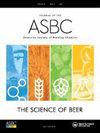加拿大无壳大麦新基因型的理化特性和酿造潜力
IF 1.8
4区 农林科学
Q4 BIOTECHNOLOGY & APPLIED MICROBIOLOGY
Journal of the American Society of Brewing Chemists
Pub Date : 2022-06-16
DOI:10.1080/03610470.2022.2065453
引用次数: 0
摘要
对无壳大麦(HB)的兴趣是由其产生非常高水平的麦芽提取物的潜力驱动的,但麦汁ß-葡聚糖水平升高和无壳麦芽酶水平不足阻碍了其广泛使用。本研究的目的是强调加拿大HB用于麦芽酿造的质量改进的最新进展。对5个高级HB品系进行了各种大麦和麦芽品质特性的评价。与AAC Synergy(一种受欢迎的两排覆盖的加拿大品种)相比,所有无壳系均表现出较低的籽粒硬度和稍低的粒重和粒径。无壳大麦品系的平均总淀粉含量(64.2%)显著高于AAC Synergy(59.9%),略低于CDC Clear(65.1%)。尽管脆性值较低,但HB麦芽具有易碎的质地,具有良好的溶解度和酶接近性,从而产生充足的可发酵糖。新HB品系麦汁中淀粉水解产物的平均链长与AAC Synergy相似,说明酶活性充足,水解效率高。无壳麦芽精磨提取物的含量平均比AAC Synergy高8%,几个新HB品系的含量超过CDC Clear提取物的含量0.7-1.0%。与CDC Clear相比,新的HB系显示麦汁ß-葡聚糖浓度显著降低。HB系麦汁中阿拉伯糖低聚糖的浓度和平均聚合度普遍高于AAC协同麦汁,这在一定程度上解释了HB系麦汁粘度较高的原因。总的来说,最近开发的HB系表现出良好的麦芽潜力,麦芽汁中麦芽酶水平、游离氨基氮化合物浓度和β-葡聚糖含量显著提高。本文章由计算机程序翻译,如有差异,请以英文原文为准。
Physicochemical Properties and Malting Potential of New Canadian Hulless Barley Genotypes
Abstract Interest in malting hulless barley (HB) is driven by its potential to produce very high levels of malt extract, but elevated levels of wort ß-glucan and insufficient levels of enzymes in hulless malt have prevented its widespread use. The objective of this study was to highlight the recent advancements in quality improvement of Canadian HB for malting purposes. Five advanced HB lines were evaluated for various barley and malt quality characteristics. All hulless lines exhibited lower grain hardness and slightly lower kernel weight and diameter compared to AAC Synergy (a popular two-rowed covered Canadian variety). The average total starch content of the hulless barley lines (64.2%) was significantly higher than AAC Synergy (59.9%) but slightly lower than that of CDC Clear (65.1%). Despite the low friability values, HB malts had a crumbly texture with good solubility and enzyme accessibility resulting in ample production of fermentable sugars. The average chain length of starch hydrolysis products in wort of new HB lines was similar to that of AAC Synergy, indicating sufficient enzyme activities and a highly effective hydrolysis. The fine-grind extract levels from hulless malt were on average 8% higher than from AAC Synergy, and several new HB lines exceeded the level of CDC Clear extract by 0.7–1.0%. Compared to CDC Clear, the new HB lines showed a significant reduction in concentration of wort ß-glucans. The concentration and the average degree of polymerization of arabinoxylo-oligosaccharides in wort of HB lines were generally higher than in wort of AAC Synergy, partly explaining the higher viscosity of HB worts. In general, the recently developed HB lines exhibited excellent malting potential with significant improvements in the levels of malt enzymes, concentration of free amino nitrogen compounds, and β-glucans in wort.
求助全文
通过发布文献求助,成功后即可免费获取论文全文。
去求助
来源期刊

Journal of the American Society of Brewing Chemists
工程技术-生物工程与应用微生物
CiteScore
4.00
自引率
20.00%
发文量
41
审稿时长
3 months
期刊介绍:
The Journal of the American Society of Brewing Chemists publishes scientific papers, review articles, and technical reports pertaining to the chemistry, microbiology, and technology of brewing and distilling, as well as the analytical techniques used in the malting, brewing, and distilling industries.
 求助内容:
求助内容: 应助结果提醒方式:
应助结果提醒方式:


